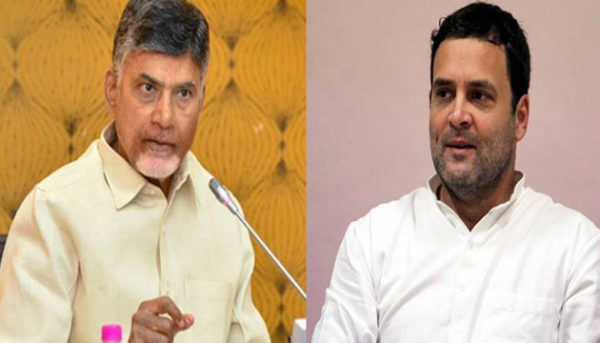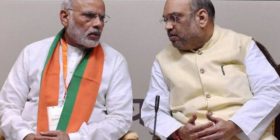Andhra Pradesh chief minister and Telugu Desam Party (TDP) president N Chandrababu Naidu’s anti-Modi crusade reached a new level of propulsion on Thursday, as he joined Nationalist Congress Party (NCP) chief Sharad Pawar and National Conference president Farooq Abudallah in a bid to unite all the parties opposed to the Bharatiya Janata Party (BJP). The two senior leaders authorised Naidu to speak to other parties that have a common agenda to forge an anti-BJP front in the run-up to the 2019 Lok Sabha elections. The three leaders also decided to consult other like-minded parties to chalk out a common minimum programme.
Before meeting Pawar and Abdullah, the TDP chief had also called on Aam Aadmi Party president and Delhi chief minister Arvind Kejriwal, Loktantrik Janata Dal chief Sharad Yadav and Bahujan Samaj Party (BSP) chief Mayawati.
However, Naidu is neither the first, nor will he be the last, leader to take up such a crusade to unveil a third or federal front. In fact, the Congress itself has attempted to forge Opposition unity, with Sonia Gandhi having invited leaders of non-BJP parties in the past. But as several outfits have their own reservations and political interests in accepting the leadership of the Congress, nothing substantial can emerge at least before the 2019 polls.
So far, attempts to unite non-BJP or anti-BJP parties have yielded mixed results. The united fight by the Samajwadi Party, BSP, Rashtriya Lok Dal (RLD) and the Congress saw positive results in the Kairana bypolls in Uttar Pradesh. However, despite the critical importance of unity between the Congress and BSP to dislodge the saffron party in its strongholds of Madhya Pradesh, Rajasthan and Chhattisgarh, nothing of that sort could materialise.
Telangana Rashtra Samithi (TRS) supremo and Telangana chief minister K Chandrashekar Rao (KCR) was yet another leader who had tried to unite regional parties. However, as he met only a select group of politicians who were either part of the Congress-led alliance or likely allies of the party, political circles began to view KCR’s intentions with suspicion. Some even believed that KCR was doing this at the behest of the Modi-Shah duo to harm the Congress — the common enemy — by preventing other regional parties from gravitating towards the Grand Old Party.
Trinamool Congress president and West Bengal chief minister Mamata Banerjee was yet another important leader who talked about the need for unity among anti-BJP forces. But given the fact that she nurses national ambitions, her competitors within the regional spectrum, including Pawar and even the Congress, were always sceptical.
On all these occasions, regardless of who made the attempt, the parties with political compulsions to oppose the BJP responded positively. Yet, a front and common minimum programme still elude because of inherent contradictions in the non-BJP camp.
However, Naidu was candid when he said that political compulsions will force non-BJP parties to come together to form a third front against it.
Mulayam Singh Yadav’s national ambitions were almost laid to rest with the crisis in the Samajwadi Party. Also, with the gradual weakening of the BSP in its own state Uttar Pradesh, Mayawati’s national ambitions were hard hit, as well.
After these experiences to unite the Opposition, Naidu has now made a fresh attempt to forge a front to take on the BJP, and to undertake this exercise, he certainly has a number of advantages. For one, Naidu is no longer with the National Democratic Alliance (NDA) and has shed his pathological aversion towards the Congress, against which TDP founder NT Rama Rao had floated the party. Naidu seems to be best suited to bring the Opposition together against the BJP, given his experience with the Congress when he brought together the 13-party United Front in 1996-1998, as well as with the BJP-led first NDA government.
Leaders like Pawar, Mamata and Mayawati do not consider Naidu a contender anymore, especially since the bifurcation of Andhra Pradesh. The united state had 42 seats in the Lok Sabha, while the current Andhra Pradesh — where Naidu’s politics have been restricted to primarily — has only 25 seats in the Lower House, much lower than Uttar Pradesh, West Bengal or Maharashtra.
On one hand, the Congress is bound to have reservations about Pawar and Mayawati as their NCP and BSP are its competitors in the states where it has much at stake, and the same holds true in Mamata’s case.
On the other hand, however, the Congress has been decimated in Andhra Pradesh because of the alleged arbitrary bifurcation of the state. This means that it desperately needs Naidu for its revival in Andhra Pradesh. Naidu, too, is keen on embracing the Congress due to the electoral arithmetic at play since he walked out of the NDA and his fallout with Pawan Kalyan and his Jana Sena Party.
However, retaining power in Andhra Pradesh is paramount for Naidu, even more than the national political odyssey, as he has to install his son Nara Lokesh. But people close to Naidu have yet to dismiss his national aspirations, especially as his son, who is a minister in his cabinet, is all set for political succession.
Although Naidu has national ambitions, his Delhi parleys are primarily aimed at enhancing his strength in Andhra Pradesh through the electoral arithmetic.
With Naidu meeting Congress chief Rahul Gandhi, the TDP has made a strange, yet remarkable, turn in its historical destiny. The Andhra Pradesh chief minister has intelligently posit his political interest in the state in the national framework to avert any possible antipathy towards his alliance with the Congress at home.
The TDP had won the 2014 election with only a 2 percent margin with the support of the BJP and Pawan Kalyan. As both parties are now estranged, the TDP is desperately looking even for an incremental addition to its votes to avoid a possible flip-flop. However, given the anti-Congress sentiments in Andhra Pradesh on the basis of the narrative around the bifurcation, which Naidu nurtured himself all these years, the TDP wants to carefully couch his new-found love for the Congress in an anti-BJP national perspective.






Leave a reply